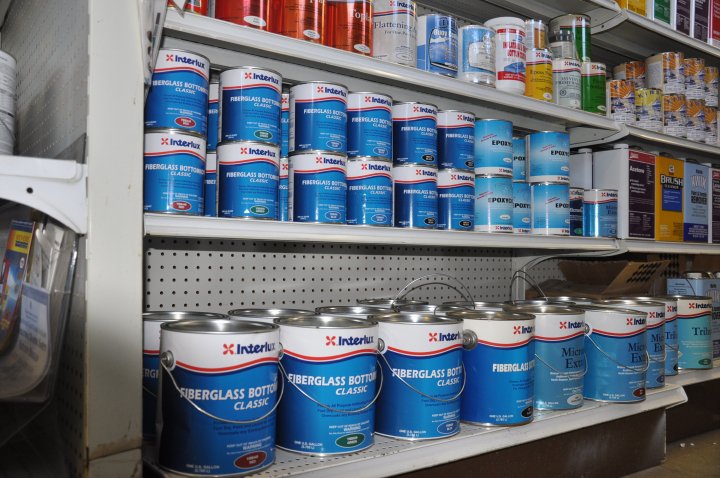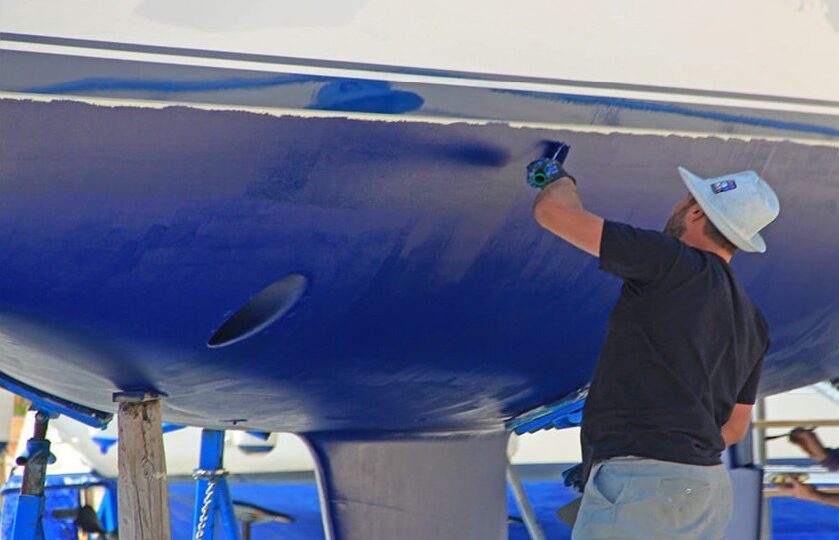Best Antifouling Bottom Paint for Boats
Applying antifouling paints on your boat will eliminate marine growth and maximize your boat’s efficiency. Bottom paints contain chemicals that prevent underwater growth in order to protect your hull. Most paints contain copper compounds while others are water-based or copper-free. Basic types of antifouling paints include ablative bottom paints and hard bottom paints. As we’ve previously seen in another article, there are different groups and types of bottom paints. In general, before painting the hull, you should first consider how often you use your boat and what type of paint you applied in the past. This is because not all paints are compatible with others. For instance, vinyl paints should only be applied on previously vinyl-painted surfaces. But let’s now see which are the best bottom paints for boats as well as which one suits your boat! Follow me!
How to Choose the Best Bottom Paint for your Boat
Choosing the best bottom paint for your boat is not a simple decision to make. And, how will you choose from all these available options in today’s market? Keep reading so as to put things in order and give an answer to your concerns. Here are the most important factors to keep in mind before selecting the right antifouling paint for your boat.
- The type of your boat, the average speed, and boat usage: The frequency in which you use your boat, and what type of boating you do are also important factors before choosing a bottom paint. For example, if you’re an occasional sailor then a single-season antifouling paint will work just fine. But, if you’re regularly sailing overseas then it’s recommended to use a multi-season and effective bottom paint. Also, in case you trailer your sailboat then consider an ablative antifouling paint.
- Your budget and desired durability of the paint: Bottom paints tend to be expensive. But, as aforementioned, if sailing frequently then it’s advisable to use a highly-durable, effective, and environmentally-friendly bottom paint. Some properties that increase the cost of an antifouling paint are the amount of biocide, multi-season effectiveness, self-polishing ability as well as the level of preventing marine growth.
- Previous and existing hull coatings: If you have already painted the hull then you need to know whether the new bottom paint is compatible or not with the previous one. However, in case you don’t know the type of the previous paint or if you think that it’s incompatible with the new paint, it’s better to remove it completely before applying the new bottom paint.
Environmental Factors
Other important factors to consider are related to the environment. On the one hand, the environment in which you’re sailing will determine what kind of bottom paint you’re going to use. On the other, environmental restrictions and regulations play a huge role in the matter of antifouling paints. This is because the use of biocides in the marine environment has proved to be really harmful as it has considerable toxic effects.
- Water environments to which you’re sailing to. Are you sailing in freshwater or saltwater environments? The answer will determine the type of fouling, i.e. light, moderate, or heavy, and how you can deal with it. Copper-based paints are considered the most effective ones but also the most toxic for the marine environment. Copper-free paints, such as ECONEA, are also effective on hard fouling organisms, like acorn barnacles. But, in case algae and slime cause a problem in the sailing area you’re going to, you might want to use a paint containing an algaecide such as zinc pyrithione. Keep in mind that more biofouling occurs in warm waters rather than colder ones.
- Environmental restrictions: As sailors, we have to be responsible and protect the marine environment. There are specific restrictions that regulate VOC (volatile organic compound) and copper content in certain areas. Also, many places require the use of ablative antifouling paints that are water-based, and that’s a huge plus!
How to Apply and Remove the Antifouling Paint
Tips for Applying New Bottom Paint:
- Firstly, give a high-pressure freshwater wash and rinse the hull thoroughly.
- Select the right paint accessories and safety equipment for the paint you are applying. Always wear a respirator, gloves, protective eyewear, and special clothing.
- Check for damages with suitable epoxy filler and inspect the hull for Gelcoat damage or osmosis.
- Place a tarp or filter cloth under the hull to catch the spills.
- Follow the manufacturers’ instructions that recommend the number of coats needed.
- Apply the antifouling at the correct thickness. This depends on application methods and conditions.
Tips for Removing Bottom Paint:
There are three ways for removing antifouling paint and they include sanding, chemical paint strippers, or soda blasting by professionals. The tips below are referred to the paint stripping option.
- Scrub the hull and use a stripper for changing the bottom paint. The Back to Nature strippers are environmentally safe and easy to use.
- If you decide to sand in order to remove layers of paint then make sure to solvent-wipe the surface prior to sanding so as to remove any grease, dirt, and wax.
- Place a tarp under the sailboat to catch scraping chips.
- Avoid removing large areas of antifouling by dry sanding. This is risky for yourself and for the environment. It’s advisable to place a tent over the boat in order to restrict airborne particles. Also, try to wet sand and consider using a vacuum sander to remove old paint.
- Collect any waste and safely dispose of them in a hazardous waste receptacle.

Best Bottom Paints
CFA eco — Copper Free Ablative
A copper-free paint with a formula of ECONEA and Zinc biocide that ensures multi-season protection. This dual biocide is quite environmentally safe, works great against slime, has low VOCs, and has no intense smell. You can safely use it on all substrates including aluminum.
Sea Hawk Tropikote
This hard epoxy antifouling paint uses high-quality cuprous oxide and fights effectively all kinds of marine growth and slime. Moreover, with this paint, you’ll avoid regular maintenance. It’s a great coating for year-round boaters. Check it out on Amazon.
Pettit Ultima Eco Bottom Paint
This metal-free paint contains a dual biocide that efficiently controls both hard and soft fouling on different substrates. The paint contains organic ECONEA biocide and a powerful slime fighting agent. Lastly, the self-polishing ablative technology eliminates the need for sanding and paint build-up. Check the product right here.
TotalBoat Underdog Boat Bottom Paint
This high-quality solvent-based antifouling paint offers excellent protection qualities. It has a powerful paint formula and effective ablative action that protects the boat from all kinds of marine growth. The formula releases approximately 25% of copper at a controlled rate that keeps away the light or hard growth of grasses, algae, and slime. See more details about the TotalBoat Underdog Boat Bottom Antifouling Paint on Amazon.
Rust-Oleum Marine Flat Boat Antifouling Paint
This paint is ideal if you’re launching your boat after a long time. According to reviews, its excellent performance prevents barnacles, algae, and other marine organisms from growing on the hull. It has a durable protective coating which works great on steel surfaces but not on aluminum ones. Moreover, it contains around 45% of cuprous oxide that makes it one of the hardest bottom paints. Check it out on Amazon.
Interlux Ultra with Biolux Antifouling Paint
This paint’s formula is excellent for high fouling areas and ensures long-term antifouling protection. It benefits from the fast dry and low VOC formula that allows painting and launching your boat on the same day! Check it out right here.
Flexdel Aquagard Antifoulant Bottom Paint
This eco-friendly water-based paint is highly-efficient for application on different surfaces and ensures a quick dry. By applying several coatings you ensure longevity and prevention of marine growth. Even though it’s expensive it really worths the investment, so, check it out right here.
Aluma Hawk Aluminum Boat Paint
This paint is ideal for application on fiberglass and aluminum boats. Highly preferred by many sailors due to its effectiveness and ease of use. By applying just one to two coatings you can save some time and effort. Moreover, it dries quickly and prevents corrosion but it’s quite thick, so make sure to use a thinner before applying. Check out more details on Amazon.
Pettit Paint Hydrocoat ECO
This water-based and copolymer ablative bottom paint wears away with use, reveals a new surface, and then eliminates paint buildup. It contains the highest level of ECONEA which protects both the hull and the marine environment. Along with the slime-fighting inhibitor, the formula offers multiple seasons of protection. In addition, there’s no need to sand between coats, and depending on the environment, it will likely last for multiple seasons. Lastly, the copper-free formula is great for different substrates like steel, GRP, or aluminum. Check it out on Amazon.
TotalBoat Krypton Boat Paint
Another environmentally friendly ablative paint from TotalBoat that ensures effectiveness and ease of use. This is because its great formula contains a sufficient concentration of ECONEA combined with slime-fighting zinc. You can apply it on aluminum, fiberglass, steel, or even wood sailboats in both fresh and saltwater. Furthermore, you can use it on different underwater metals such as outdrives and trim tabs. It comes out in five colors and is available in gallons or quarts. Check the TotalBoat Krypton Copper Free Antifouling on Amazon.
Best Boat Bottom Paint – Summary
In order to find out which paint is the best for your boat keep in mind some important factors. Firstly, if you’re sailing in a freshwater or saltwater environment. Secondly, the environmental restrictions and negative impact that the paint will cause on marine life. Thirdly, if your boat will be trailered or stay in the water year-round. Also, the material of your hull and, of course, how often you use your boat. If you know these key factors then you’ll be ready to choose between the above-mentioned antifouling paints. These paints are considered the best in today’s market. Lastly, I highly encourage you to purchase eco-friendly and water-based paint because nowadays, they’re as effective as copper-based or hard epoxy paints are. I hope that this article was helpful and that you’ll be able to easily choose the best paint for your sailboat!
